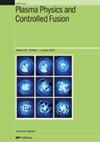基于卷积自动编码器的等离子体破坏预测器的跨托卡马克部署研究
IF 2.3
2区 物理与天体物理
Q2 PHYSICS, FLUIDS & PLASMAS
引用次数: 0
摘要
在未来托卡马克运行的初始阶段,面对有限的数据可用性,部署数据驱动的中断预测器需要在尽量少使用新设备数据的情况下获得最佳性能。本文研究了跨托卡马克部署过程中数据驱动中断预测器的数据利用问题。目前的预测器主要采用监督学习方法,需要大量的中断和非中断镜头进行训练。然而,由于未来托卡马克干扰镜头的稀缺性和获取成本的高昂性,导致了训练数据集的不平衡,降低了监督学习预测器的性能。为了解决这个问题,我们提出了增强型卷积自动编码器异常检测(E-CAAD)预测器。E-CAAD 可仅通过非中断样本进行训练,也可在中断发生时通过中断前兆样本进行训练。该模型不仅克服了监督学习预测器中的样本不平衡问题,还克服了传统异常检测预测器无法使用中断前兆样本进行训练所面临的数据集利用效率低的问题,使其更适合未来托卡马克不可预测的数据集。与传统的异常检测预测器相比,E-CAAD 预测器在中断预测方面表现更好,在新设备上的部署速度也更快。此外,我们还探索了利用现有设备的数据加速在新设备上部署 E-CAAD 预测器的策略。我们提出了两种部署策略:混合现有设备的数据和微调在现有设备上训练的预测器。我们的比较结果表明,现有设备的数据可以加快预测器在新设备上的部署。值得注意的是,在所设计的策略中,微调策略在新设备上的部署速度最快。本文章由计算机程序翻译,如有差异,请以英文原文为准。
Cross-tokamak deployment study of plasma disruption predictors based on convolutional autoencoder
In the initial stages of operation for future tokamak, facing limited data availability, deploying data-driven disruption predictors requires optimal performance with minimal use of new device data. This paper studies the issue of data utilization in data-driven disruption predictor during cross tokamak deployment. Current predictors primarily employ supervised learning methods and require a large number of disruption and non-disruption shots for training. However, the scarcity and high cost of obtaining disruption shots for future tokamaks result in imbalanced training datasets, reducing the performance of supervised learning predictors. To solve this problem, we propose the Enhanced Convolutional Autoencoder Anomaly Detection (E-CAAD) predictor. E-CAAD can be trained only by non-disruption samples and can also be trained by disruption precursor samples when disruption shots occur. This model not only overcomes the sample imbalance in supervised learning predictors, but also overcomes the inefficient dataset utilization faced by traditional anomaly detection predictors that cannot use disruption precursor samples for training, making it more suitable for the unpredictable datasets of future tokamaks. Compared to traditional anomaly detection predictors, the E-CAAD predictor performs better in disruption prediction and is deployed faster on new devices. Additionally, we explore strategies to accelerate the deployment of the E-CAAD predictor on the new device by using data from existing devices. Two deployment strategies are presented: mixing data from existing devices and fine-tuning the predictor trained on existing devices. Our comparisons indicate that the data from existing device can accelerate the deployment of predictor on new device. Notably, the fine-tuning strategy yields the fastest deployment on new device among the designed strategies.
求助全文
通过发布文献求助,成功后即可免费获取论文全文。
去求助
来源期刊

Plasma Physics and Controlled Fusion
物理-物理:核物理
CiteScore
4.50
自引率
13.60%
发文量
224
审稿时长
4.5 months
期刊介绍:
Plasma Physics and Controlled Fusion covers all aspects of the physics of hot, highly ionised plasmas. This includes results of current experimental and theoretical research on all aspects of the physics of high-temperature plasmas and of controlled nuclear fusion, including the basic phenomena in highly-ionised gases in the laboratory, in the ionosphere and in space, in magnetic-confinement and inertial-confinement fusion as well as related diagnostic methods.
Papers with a technological emphasis, for example in such topics as plasma control, fusion technology and diagnostics, are welcomed when the plasma physics is an integral part of the paper or when the technology is unique to plasma applications or new to the field of plasma physics. Papers on dusty plasma physics are welcome when there is a clear relevance to fusion.
 求助内容:
求助内容: 应助结果提醒方式:
应助结果提醒方式:


